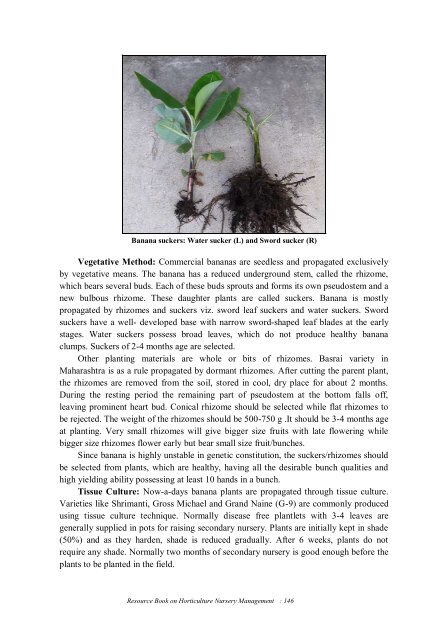Resource Book on Horticulture Nursery Management
Resource Book on Horticulture Nursery Management
Resource Book on Horticulture Nursery Management
Create successful ePaper yourself
Turn your PDF publications into a flip-book with our unique Google optimized e-Paper software.
Banana suckers: Water sucker (L) and Sword sucker (R)<br />
Vegetative Method: Commercial bananas are seedless and propagated exclusively<br />
by vegetative means. The banana has a reduced underground stem, called the rhizome,<br />
which bears several buds. Each of these buds sprouts and forms its own pseudostem and a<br />
new bulbous rhizome. These daughter plants are called suckers. Banana is mostly<br />
propagated by rhizomes and suckers viz. sword leaf suckers and water suckers. Sword<br />
suckers have a well- developed base with narrow sword-shaped leaf blades at the early<br />
stages. Water suckers possess broad leaves, which do not produce healthy banana<br />
clumps. Suckers of 2-4 m<strong>on</strong>ths age are selected.<br />
Other planting materials are whole or bits of rhizomes. Basrai variety in<br />
Maharashtra is as a rule propagated by dormant rhizomes. After cutting the parent plant,<br />
the rhizomes are removed from the soil, stored in cool, dry place for about 2 m<strong>on</strong>ths.<br />
During the resting period the remaining part of pseudostem at the bottom falls off,<br />
leaving prominent heart bud. C<strong>on</strong>ical rhizome should be selected while flat rhizomes to<br />
be rejected. The weight of the rhizomes should be 500-750 g .It should be 3-4 m<strong>on</strong>ths age<br />
at planting. Very small rhizomes will give bigger size fruits with late flowering while<br />
bigger size rhizomes flower early but bear small size fruit/bunches.<br />
Since banana is highly unstable in genetic c<strong>on</strong>stituti<strong>on</strong>, the suckers/rhizomes should<br />
be selected from plants, which are healthy, having all the desirable bunch qualities and<br />
high yielding ability possessing at least 10 hands in a bunch.<br />
Tissue Culture: Now-a-days banana plants are propagated through tissue culture.<br />
Varieties like Shrimanti, Gross Michael and Grand Naine (G-9) are comm<strong>on</strong>ly produced<br />
using tissue culture technique. Normally disease free plantlets with 3-4 leaves are<br />
generally supplied in pots for raising sec<strong>on</strong>dary nursery. Plants are initially kept in shade<br />
(50%) and as they harden, shade is reduced gradually. After 6 weeks, plants do not<br />
require any shade. Normally two m<strong>on</strong>ths of sec<strong>on</strong>dary nursery is good enough before the<br />
plants to be planted in the field.<br />
<str<strong>on</strong>g>Resource</str<strong>on</strong>g> <str<strong>on</strong>g>Book</str<strong>on</strong>g> <strong>on</strong> <strong>Horticulture</strong> <strong>Nursery</strong> <strong>Management</strong> : 146











